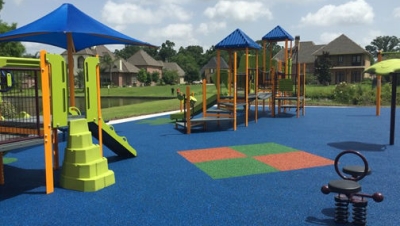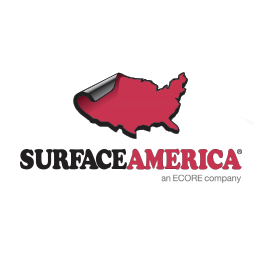Put some spring into your step!
What do we know of poured-in-place surfacing? Walk on it. You might find yourself compelled to do a little hopping around. It’s very cushy and springy, so no wonder it is such a popular surfacing option, and it can be made into interesting designs to boot. Most applications of this product prove to be very aesthetically pleasing, and downright fun.
Visit a few playgrounds in your area that have it. You’ll find interesting themes that may include everything from the Statue of Liberty to bear paws or a hopscotch pad incorporated into the design of many playgrounds using this material. You can create themed play environments as well as including icons that lead from one play event to another to encourage continuous and imaginative play.
There is more involved than just choosing colors and designs with it though, and most people don’t understand this. Part of the reason for this is that most committees designing and choosing structures and surfacing are likely doing this for the first time. Hopefully, they find out at the onset of the project that there are standards set forth by the American Society for Testing of Materials, ASTM. Rolf Huber, a member of the ASTM F08.63 sub-committee, shed a little light on the standards.
Protective surfacing must meet the ASTM F1292 Standard, and the language of the standards is very technical in nature, so some may find it a bit daunting and in effect say, “Just give me the product I am supposed to have, and at the thickness it should be,” says Huber, instead of really diving in and learning the specifics. Huber notes that it’s important to know what you’re buying. You want a quality product that will be installed properly and will last.
The F08.63 sub-committee of ASTM has written a number of documents for making surfacing and the standards easier to understand. In 2004 it published ASTM F2223, Standard Guide for ASTM Standards on Playground Surfacing, to help the layperson more easily comprehend what the standards are so better informed decisions on their purchase of protective surfacing can be made.
It has also published ASTM F2075, Standard Specification for Engineered Wood Fiber, for Use as a Playground Safety Surface Under and Around Playground Equipment; the ASTM F2479, Standard Guide for Specification, Purchase, Installation and Maintenance of Poured-In-Place Playground Surfacing; and has worked on other standards that are performance-based for poured-in-place and loose rubber systems.
"Functional longevity" is a goal of the committee writing the standards. "Making sure a protective surfacing is not only going to last, but that it maintains its function of providing the required impact attenuation to reduce life-threatening injuries," says Huber, is what the ASTM is working toward. Why do you need to know so much about it? If you become familiar with the standards, you will know the questions to ask the manufacturer when you are considering its product. Protective surfacing is a multi-faceted world. It’s not as simple as just calling up the manufacturer, ordering what you want, and having it installed.
If you choose poured-in-place surfacing, you will want to think about things such as the temperature and humidity of your region. This matters because the chemicals used in poured-in-place surfacing react differently to climate conditions. Even fluctuations in these factors can have a detrimental effect on the outcome of an installation. You want to choose a surfacing material that can withstand extreme temperatures if that is the norm for your region. That may or may not be poured-in-place, engineered wood fiber, tiles, mats, sand, etc. You want it to last, so be sure you are doing your homework when purchasing.
You will want to think about things such as the temperature and humidity of your region. This matters because the chemicals used in poured-in-place surfacing react differently to climate conditions
A good example of the difference in chemical reactions when curing is a newly installed playground that has a bit of color difference along the seam in the protective surfacing. This particular one is a large playground, and the installers had worked all day to reach about the halfway mark. The day had started out cooler, but the temperature was in the 80s at the end of the day when they quit. The next morning, they picked up where they left off with the same materials but with a cooler temperature. As the surfacing cured, it was noticed that the work from the first day had a little lighter color, and the section completed the next day was darker. So there is a little color change along that seam. It’s not a horrible difference and not likely to note a problem with the seam even. It’s just noticeable and a good example of how the chemicals can react in different temperatures.
There are pros and cons to using any protective surfacing material. While poured-in-place is not completely maintenance free, it does have a little different maintenance schedule than some surfaces. Because it’s a unitary surface, it stays in one place. You’ll want to check with the manufacturer for the specific maintenance schedule for any one product, as there are different brands, but most seem to stick to about a five-year maintenance schedule barring needed repairs. That means that you would likely need to do another topcoat of the sealant product every five years to help keep it in shape.
You may want to keep a "repair kit" on hand as well. That would be any extra material left from the initial installation. Just keep in mind that the glue likely has a shelf life of about six months, so if it’s needed after that amount of time, you’ll do better to purchase new glue. It doesn’t hurt to have it on hand for that time period though, just in case. Just be aware that when you call for a repair, it’s good to have extra material on hand to be sure there is enough to patch it. The hole can become quite a bit bigger during the repair, so it’s good to keep the extra on hand.
Consider fading, which may not be a problem for all poured-in-place surfaces, but it’s a good idea to incorporate some shade into the design of your playground. Shade is great on many levels, especially for protection from the sun for children on the playground during hot summer months.
When you have your surfacing installed, make sure you are working with an experienced installer. This is the last part of the playground you would want to leave to a novice for many reasons. It’s an investment of your time, effort, and money of course; and you don’t want someone guessing at how to install. You want someone with the credentials handling your project. The depth of surfacing has to be correlated with the various fall height demands of your structure, according to ASTM standards. Get to know the standards so you’re educated on what the specific needs of your playground are. Choosing protective surfacing depths conducive to higher fall heights provides better protection for falling children and adds functional longevity to your surface.
Here are a few more specifics on standards. The ASTM has also published the ASTM F2479 Standard Guide for Specification, Purchase, Installation and Maintenance of Poured-in-Place Surfacing. This offers information regarding more specifics of use of poured-in-place surfaces and also includes assistance for owner/operators in avoiding any pitfalls that might be encountered maybe due to improper installation.
It’s an investment of your time, effort and money of course; and you don’t want someone guessing at how to install.
Also make sure that your playground is tested for fall-height compliance before it is opened to the public. You can have a provision written in your surfacing contract stating that it will be tested before the installers are paid. A good strategy is to hold payments for the surface until the surface is tested in the field for contract compliance for impact attenuation. If it doesn’t pass the test, they are highly motivated to do what needs to be done to comply with the standards. You, the owner/operator, assume liability once the playground is completed, so you want to make sure that every part of the playground is compliant so that life-threatening injuries are reduced, which is the goal of these standards. ASTM F2223 also suggests that requiring better performance is a way to reduce the severity of the injury potential. Testing from the tops of guardrails and barriers and requiring lower Gmax and HIC values will give this increased protection.
If you’re interested in working with the ASTM sub-committees, visit www.astm.org for more information. There you are able to contribute your ideas and comments on protective surfacing, among other issues. You can become a member and participate electronically, and your membership includes the ability to download a volume of standards of your choice. If you’re interested mostly in playgrounds, you might choose the 15.07. Stay tuned to Playground Professionals for updates on these standards and guides.















